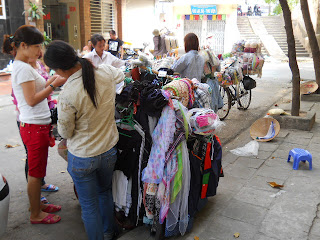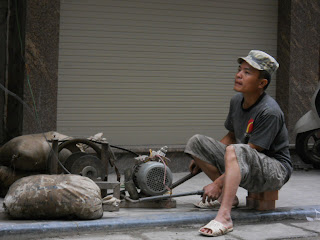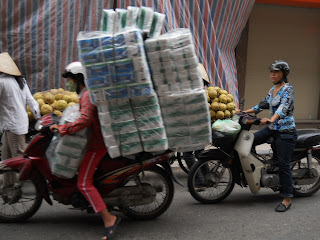 Dong Xuan Market (Vietnamese: Chợ Đồng Xuân,Chinese:同春) is the largest covered market in the central district Hoan Kiem of Hanoi, Vietnam and was built by the French administration in 1889.
Dong Xuan Market (Vietnamese: Chợ Đồng Xuân,Chinese:同春) is the largest covered market in the central district Hoan Kiem of Hanoi, Vietnam and was built by the French administration in 1889.The market is in Hanoi's Old Quarters area about 600m north of Hoan Kiem Lake.
The most recognizable feature of the market was the 5-arch entrance corresponding to Dong Xuan Market's five domes.
Dong Xuan Market has been renovated several times with the latest in 1994 after a fire which almost destroyed the market and 4.5 million USD worth of stocks became ashes.
Vehicles similar to the electric powered golf cart were many outside the market.
These E-cars were introduced by Dong Xuan Corporation and was officially launched on the 17th July 2010.
Tourists will be driven around various places such as the 28 commercial streets, 13 craft streets, 22 communal houses, 39 temples, 3 pagodas and 8 historical places around Hoan Kiem Lake and back to Dong Xuan market.
The market is run by the Dong Xuan Shareholding Company (Công ty cổ phần Đồng Xuân).
It has three storeys which are divided into stalls for wholesale and small traders who sell clothes or household goods.
Foodstuffs of every kinds from fresh vegetables to Vietnamese dishes are also found at the rear of the market.
As the biggest wholesale market of Hanoi, Dong Xuan Market has to face with several problems such as counterfeit consumer goods and pollution.
In 2003, the night market of the Dong Xuan Market was opened on the occasion of the 2003 Southeast Asian Games.

When the First Indochina War broke out in Hanoi in early 1947, a fierce struggle between Việt Minh and French forces took place in the area of the market on February 14.
To commemorate the event, a memorial was erected near the principal gate of the market in 2005.

Ethic Chinese shop selling decorative products and souvenirs.
Ladies garments and lingeries wholesale and retail.
In 2009, Vietnam was named the sixth most attractive emerging market destination for retail investment in the world by management consulting firm A.T. Kearney.

Typical family styled lunchtime servings for shop assistants.
Vietnamese eating together culture is heavily influenced by that of Southern China.
The most common utensils are chopsticks and a flat spoon.
Table manners such as chopsticks should be placed on the table or a chopstick rest after every few mouthfuls or when breaking to drink or speak.
There is a food court on the upper level of the complex.
It looked quite confusing and messy if one were to browse through the goods displayed around the shops.
The stuffs were very cheap and most were probably source from China.
Street vendors or local retailers also come here to replenish their stocks and the whole place was pretty crowded.
Vietnam is the third most populous country in Southest Asia after Indonesia and Philippines and ranked thirteen in the world so the consumers market here do offer tremendous business opportunities.
At the moment, the population showed a fair gendered distribution,with 49.5%men and 50.5% being women.
Traditional markets remain popular with the generations who were fond of the cheap prices, the familiar booths and the opportunity to exercise their bargaining skills.
Foreign firms have been showing increasing interest in Vietnam since the government opened to its door to wholly foreign-owned retails from January 1 2009, under the country’s World Trade Organization commitments.

Korea products at one of the retail outlet.
South Korea is Vietnam's third-largest trading partner; they were also the fourth-largest foreign investor after Taiwan, Japan, and Hong Kong.
Winter clothing.
The North of Vietnam experiences cool, damp winters between November and April with temperatures in Hanoi falling to around 15°C. Nice children clothings.

Fashionable ladies boots.
Colourful design of children sweaters.
Imagine the huge turnover of business with these goods waiting for delivery by local transporters.

Worker carting goods.

Similar to their Indonesian counterparts,these women used their head to carry goods.

Already one huge bale of clothings were on the motorcycle back.
He's waiting for the next bale to be loaded on. Silk fabrics and ready made ladies dresses.
Freelance women workers waiting to help carry goods.

Temporary storage area,goods on transit.
There seemed to be no system of tagging the goods to individual ownership.
This can also look like a heap of garbage.

Ladies woolen sweater.

Freelance porters waiting patiently to offer their services.

Innovative way of packing the shoes in a huge cloth bag instead of using carton boxes. This can help maximize delivery space.














































